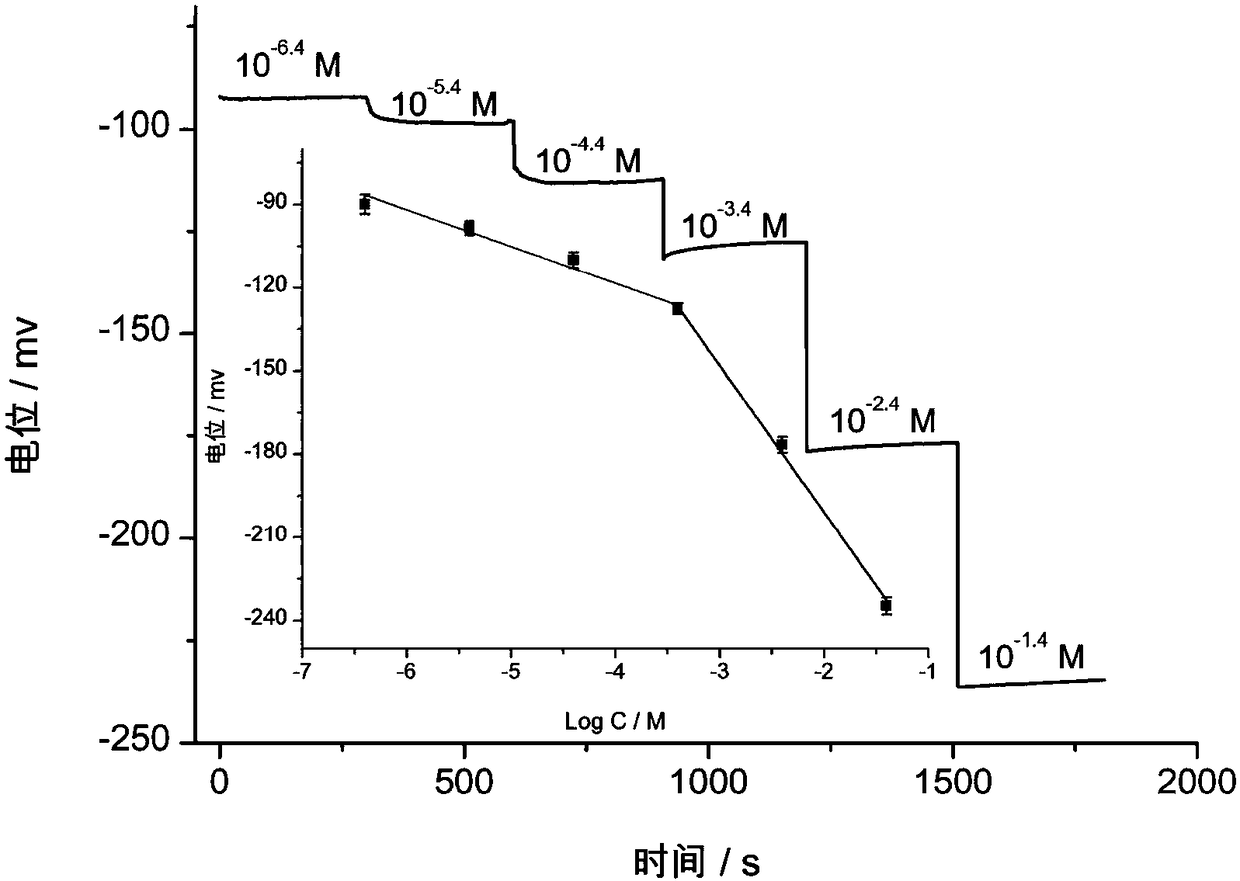A kind of fluoride ion polymer membrane potentiometric sensor and its application
A polymer membrane and potential-type technology, applied in the field of analysis and testing, can solve the problems of slow development of anion electrodes, etc., and achieve the effects of easy miniaturization, simple manufacture, and simple structure
- Summary
- Abstract
- Description
- Claims
- Application Information
AI Technical Summary
Problems solved by technology
Method used
Image
Examples
Embodiment 1
[0022] Take the detection of fluoride ion as an example. The operation steps are as follows:
[0023] The polymer film potential type sensor is a polymer film doped with tetraphenyl antimony bromide as the ion carrier adhered to the electrode substrate; it uses tetraphenyl antimony bromide as the ion carrier and the cation exchanger as the ion site, specifically preparation:
[0024] Weigh 196mg of polyvinyl chloride, 196mg of o-nitrophenyloctyl ether, 4.0mg of tetraphenylantimony bromide and 2.5mg of tetrakis(3,5-bis(trifluoromethyl)phenyl)sodium borate and dissolve in 3.0mL of tetrahydrofuran , stirred evenly and poured into a glass ring with an inner diameter of 3.5 cm fixed on a glass plate. After the tetrahydrofuran was volatilized, the membrane was cut into small discs with an inner diameter of 3 mm using a puncher and pasted on the tip of a pipette with a PVC tube at the bottom. A glycine buffer solution (containing 10 mM NaCl) with a pH of 3.0 is used in the PVC tub...
Embodiment 2
[0036] Take the detection of fluoride ion as an example. The operation steps are as follows:
[0037] The polymer film potential type sensor is a polymer film doped with tetraphenyl antimony bromide as the ion carrier adhered to the electrode substrate; it uses tetraphenyl antimony bromide as the ion carrier and the cation exchanger as the ion site, specifically preparation:
[0038] Weigh 196mg of polyvinyl chloride, 196mg of dioctyl phthalate, 4.0mg of tetraphenyl antimony bromide and 4.0mg of chromogenic ionophore IV and dissolve them in 3.0mL of tetrahydrofuran. In a glass ring with an inner diameter of 3.5 cm. After the tetrahydrofuran was volatilized, the membrane was cut into small discs with an inner diameter of 3 mm using a puncher and pasted on the tip of a pipette with a PVC tube at the bottom. A glycine buffer solution (containing 10 mM NaCl) with a pH of 3.0 is used in the PVC tube as the inner filling solution and the activation solution to activate the electr...
PUM
 Login to View More
Login to View More Abstract
Description
Claims
Application Information
 Login to View More
Login to View More - R&D
- Intellectual Property
- Life Sciences
- Materials
- Tech Scout
- Unparalleled Data Quality
- Higher Quality Content
- 60% Fewer Hallucinations
Browse by: Latest US Patents, China's latest patents, Technical Efficacy Thesaurus, Application Domain, Technology Topic, Popular Technical Reports.
© 2025 PatSnap. All rights reserved.Legal|Privacy policy|Modern Slavery Act Transparency Statement|Sitemap|About US| Contact US: help@patsnap.com

